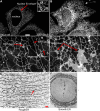The endoplasmic reticulum: structure, function and response to cellular signaling
- PMID: 26433683
- PMCID: PMC4700099
- DOI: 10.1007/s00018-015-2052-6
The endoplasmic reticulum: structure, function and response to cellular signaling
Abstract
The endoplasmic reticulum (ER) is a large, dynamic structure that serves many roles in the cell including calcium storage, protein synthesis and lipid metabolism. The diverse functions of the ER are performed by distinct domains; consisting of tubules, sheets and the nuclear envelope. Several proteins that contribute to the overall architecture and dynamics of the ER have been identified, but many questions remain as to how the ER changes shape in response to cellular cues, cell type, cell cycle state and during development of the organism. Here we discuss what is known about the dynamics of the ER, what questions remain, and how coordinated responses add to the layers of regulation in this dynamic organelle.
Keywords: Fertilization; Interphase; Mitosis; Organization; Phosphorylation; Unfolded protein response.
Figures


References
Publication types
MeSH terms
Substances
LinkOut - more resources
Full Text Sources
Other Literature Sources

